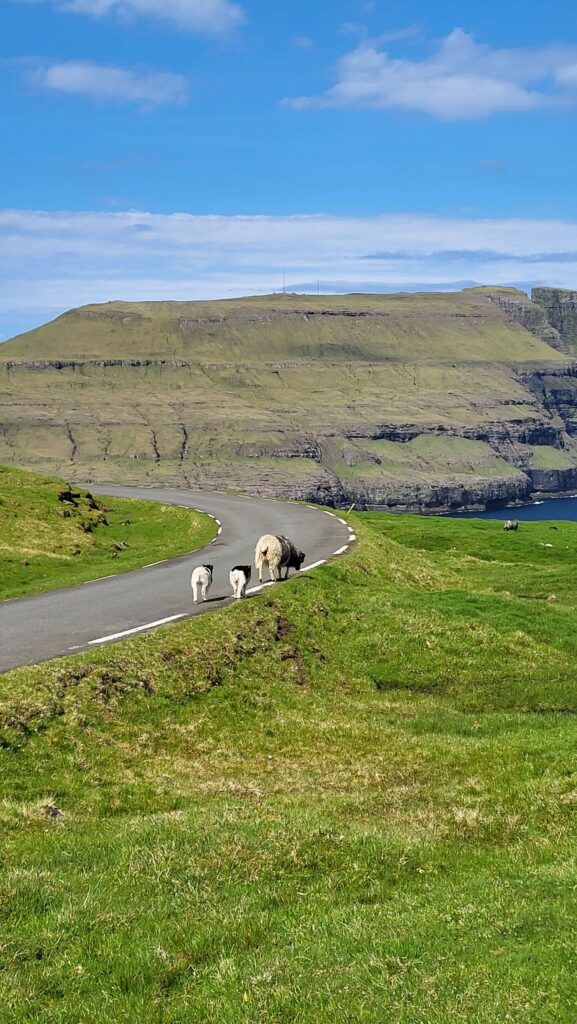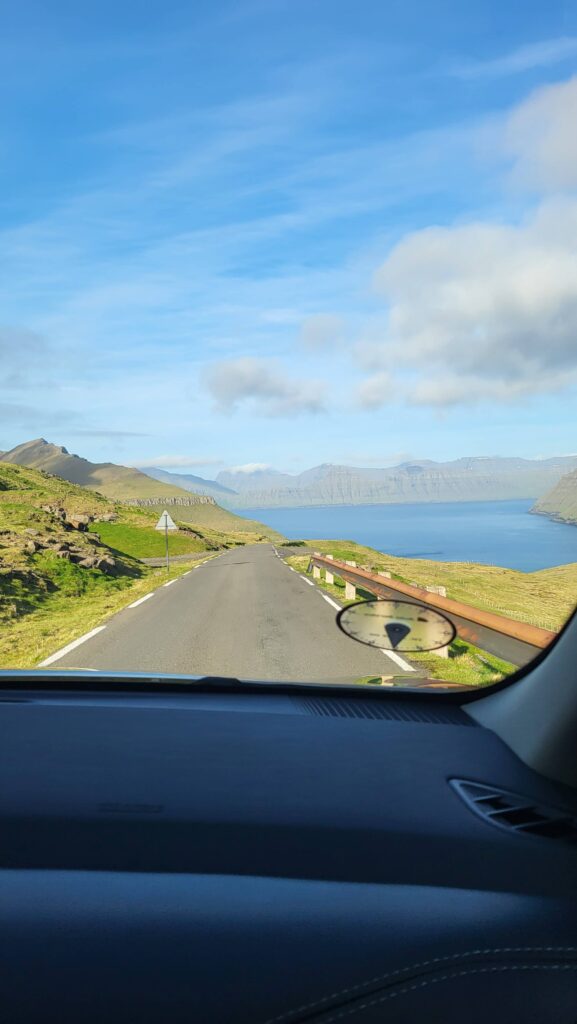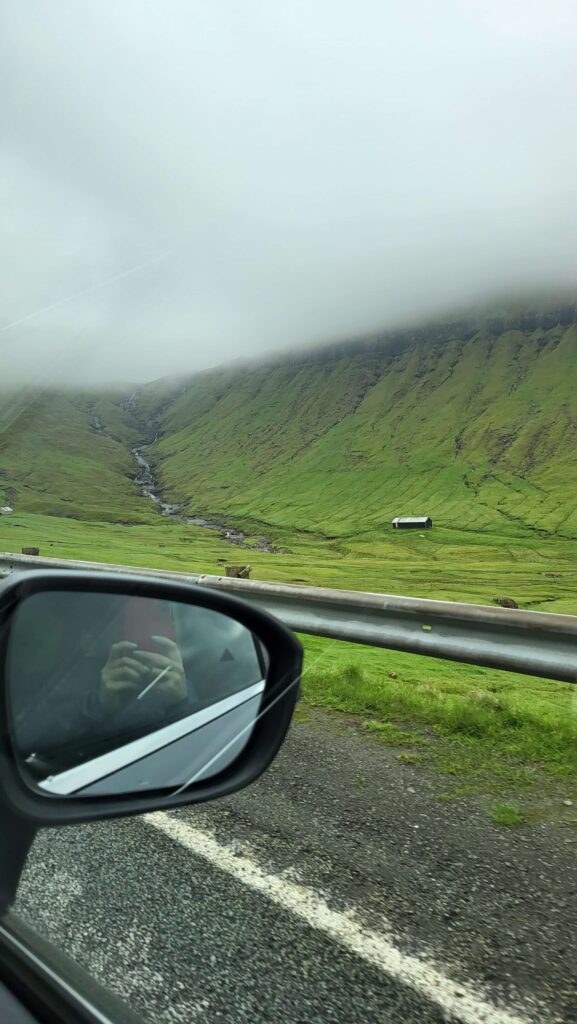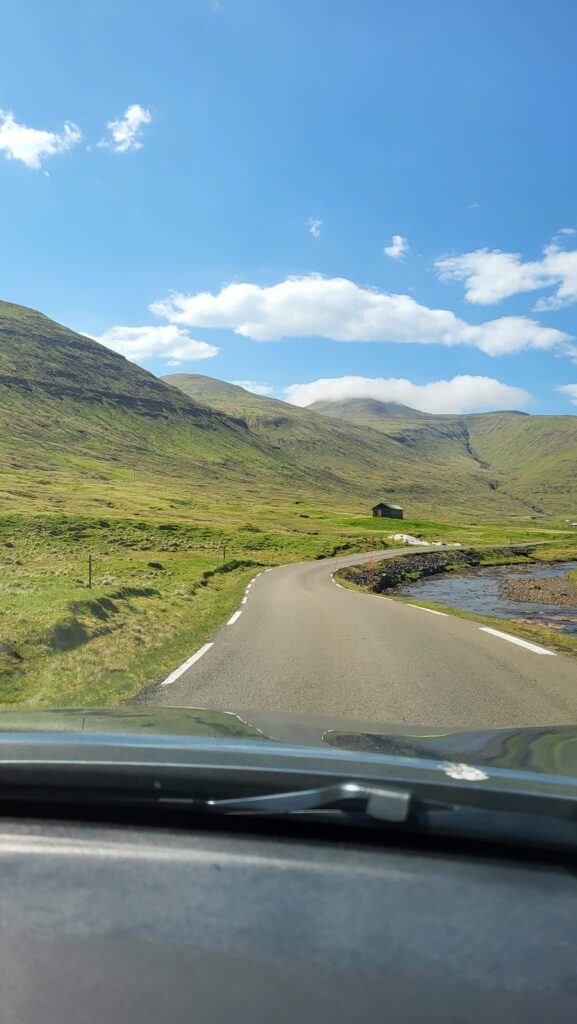
Faroe Islands: Underwater Tunnels and Driving Rules and Tips
Some posts on this website contain affiliate links. I receive a small commission if you use the links at no extra cost to you.
A road trip, or simply driving a car in the Faroe Islands, is a different level of driving.
Within a short distance, you can experience almost futuristic underwater tunnels, narrow roads or tunnels in the mountains, fabulous views and sheep on the roads.
For me, travelling by car was one of the most ‘wow’ things during my trip to the Faroe Islands in May last year.
It is worth preparing a little and learning a few rules that you have to follow on Faroese roads.
In this post, I will talk about underwater tunnels, but also other tips regarding driving in the Faroe Islands.
Faroe Islands: Car Hire
There are two ways to get to the Faroe Islands, by plane and by ferry. When travelling by ferry, you can take a car with you. However, most tourists fly to the Faroe Islands by plane and rent a car on site.
Do you need to rent a car in the Faroe Islands?
Yes, I think so.
There are public buses in the Faroe Islands, but they do not run that often and do not go everywhere. I know that there are people who decide not to have a car and just visit during one-day guided tours. However, most tourists rent a car.
There is a good reason for that. I really think it’s worth renting.
With a car, you can get to many places quickly and easily without wasting time. You will see and visit everything you want. You will also stop in many beautiful places ‘accidentally’. And you will experience these amazing routes and roads.
Car Rentals
The easiest way to rent a car is at the airport. Especially if you are not planning to sleep in the capital on that day, or you still have time for sightseeing on your arrival day.
Rental companies are right next to the terminal, which is very convenient. We rented a car from Europcar and everything worked without a problem. You can compare prices here.
Be prepared to pay a deposit. Rental companies then deduct any fines or underwater tunnel fees from it.
There are also rental companies outside the airport, for example, run by owners of guesthouses.
It’s very important to book a car in advance. Do not wait until the last minute, because the number of cars is limited.
The same applies to accommodation.
Things to remember when driving in the Faroe Islands
Driving in the Islands is easy. We had the impression that it was also pretty safe. You drive on the right side.
The speed limit is 50 km/h in built-up areas and 80 km/h outside. Fines are very expensive.
It is worth remembering about frequently changing weather conditions, rain, fog and strong winds and adjusting your speed.
Driving licence
You must always have your driving licence with you. You can drive and rent a car with EU/EEA driving licence without any problem. Other countries may need an international driving licence.
Parkings
The car parks are free (apart from the one at the airport).
In some places, there is a time limit for parking. Especially in the centre of the capital Tornshavn and in Klaksvik. In such limited parking, you will find information about how long you can park there. Then you have to mark what time you parked on a special disc/sticker with clock, which is placed on the right side of the windscreen.
You can ask for this disc at the tourist information office, but if you’re renting a car, it will most likely already have it. Our car had a sticker like that.
You only use it in the limited car parks that state it.
Sheep on roads
The name Faroe Islands definitely didn’t come out of nowhere. There are more sheep than people on the Islands. Sheep freely roam along, and even on, the roads. It’s a big attraction for tourists and another thing that makes driving special. But it also means you simply have to watch out for them, because you never know when they’ll come onto the road.
I had the impression that you had to watch out for the little ones first. They’re born in the spring, so there were a lot of them in May. They were so cute, but they really did look lost and entered onto the roads often.
It can still happen that you unfortunately hit a sheep. It is very important to report this to the police on +298 351448.
The sheep owners are insured and can get compensation for a sheep that gets hit. But it must be reported to the police.



Underwater tunnels in the Faroe Islands
Probably not many people even know about the underwater tunnels in the Faroe Islands. They are really exceptional.
The tunnels connected various islands, which made life much easier for the residents (and automatically for other visitors as well). It sped up travel and made it independent of the weather.
In some places in the tunnels there are colourful lights and art installations, which makes it even more impressive.
During your first ride, the feeling is unique. Although you can’t see it directly that it is an underwater tunnel, which is going down to a depth of up to 150 meters below sea level. I felt this change in pressure in my ears.
We felt the strangest when driving to the island of Sandoy, as there were not many cars and for a few kilometres we drove almost alone. I don’t know if it is usually like this in this tunnel, or if it was related to the time when we drove through the tunnel (before the main season, and during a strike).
Also, because there was no phone or internet reach in the tunnel. However, there are telephones placed from time to time from which you can call for help.
How many underwater tunnels are there
The first tunnel, opened in 2002, was the almost 5-kilometre Vágar Tunnel (Vágatunnilin). It’s a tunnel connecting the island of Vágar, where the airport is located, with the island of Streymoy, where the capital, Tórshavn, is located.
It will most likely be the first tunnel you drive through.
There are currently 4 underwater tunnels:
• Vágatunnilin
• Eysturoyartunnilin, 11.4 km long, connects Streymoy Island with Eysturoy
• Norðoyatunnilin, 6.2 km long, connects Leirvik on Eysturoy Island with Klaksvik on Borðoy
• Sandoyartunnilin, 10.8 km long, connects Streymoy with Sandoy Island
There are also plans for building a new tunnel, which will connect Sandoy Island with Suðuroy Island.
The tunnels are paid for, and there are different ways to pay for them. You can find details and prices here.
However, if you are renting a car, the rental company will most likely pay for you: from a deposit or from your card. Ask about it and confirm with them.
You can skip some of the tunnels and take the longer ‘old’ route.
Underwater roundabout
As if that wasn’t enough, one of the tunnels also houses the world’s first underwater roundabout called ‘Jellyfish’. The roundabout also looks interesting because of the art installation by local artist Tróndur Patursson.
Driving through this tunnel and seeing the roundabout is definitely a must-see when visiting the Faroe Islands.



Mountain tunnels and narrow roads
Roads in the Faroe Islands (apart from underwater tunnels) are free of charge. Some of these main roads are excellent roads. However, when you are sightseeing, you will also drive on very narrow ones. Some are quite winding and lead up and down.
These roads have lay-bys, so that it is easier to pass a car coming from the opposite direction. I admit that this was a bit stressful for me at first, but it turned out that it works quite ‘naturally’.
Lay-bys cannot be used as a car park or a viewpoint.
Similar lay-bys are located in narrow mountain tunnels.
Also be careful before entering, looking for signs before the tunnel.
They inform whether the tunnel is single or dual lane, and in the case of narrow ones, they show who has the right of way and who should wait in the lay-by.
I don’t know if it’s a written or unwritten rule, but from what I’ve read, if you pass a larger vehicle, a bus or a truck, it always has the right of way.
Tunnels are an important part of transport, which has also made life much easier, and you definitely won’t miss them.
Summary
As you can see, getting around the Faroe Islands is an incredibly interesting attraction. The views while driving are unforgettable. They also change depending on the weather. Views look completely different in the sun, differently in the fog.
I was most impressed by the road to Gjógv and Saksun, and by the underwater tunnels. Nevertheless, everywhere was beautiful.
That’s why it’s worth renting a car, giving yourself time to admire and stop in the most beautiful places.
Here you can read more about the Faroe Islands:
Do you like northern destinations? Here you can read about Finnish Lapland.




